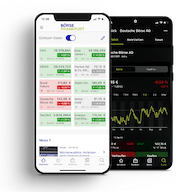Bonds: "Secure yields quickly“

Falling inflation rates and a deterioration in economic sentiment make further interest rate cuts in the eurozone increasingly likely. Bonds with relatively high yields are therefore in high demand on the Frankfurt Stock Exchange.
27 September 2024. FRANKFURT (Börse Frankfurt). The inflation data from France and Spain published at the end of the week underpinned the current trend towards falling inflation rates. As the economy in the eurozone is not gaining momentum at the same time, the window for further key interest rate cuts is automatically opening. The analysts at LBBW assume that the next ECB decision ‘will probably be more exciting than expected’. On the futures markets, a cut of 25 basis points in October is now being priced in with a probability of 70 per cent.
52 central banks with 126 interest rate cuts in 2024
Robert Halver from Baader Bank assumes that the ECB will make two more interest rate cuts by the end of the year to mitigate recession risks and that the trend will continue in 2025. According to Halver, 52 central banks worldwide have already cut their interest rates a total of 126 times so far this year, ‘as the genie of official inflation is back in the bottle’. This week, the Swiss National Bank, among others, eased its monetary policy for the third time in a row and announced further interest rate cuts.
The international turnaround in interest rates is also reflected in largely falling bond yields. However, while long-dated bonds have remained relatively stable recently, yields on short-dated bonds remain under pressure. Two-year German government bonds are currently yielding 2.13 per cent (previous week: 2.23 per cent), while ten-year bonds are virtually unchanged at 2.19 per cent. ‘At the short end, the key interest rate cuts are clearly noticeable,’ states Tim Oechsner from Steubing AG. In view of the latest development, the trader speaks of a normalisation of the yield curve. ‘The atypical situation of short interest rates being higher than long interest rates is slowly clearing up’. The yield curve is becoming steeper again.

Long-dated corporate bonds in demand
The bond specialists at Commerzbank assume that this trend will continue. As they currently see ‘little reason for even lower long-term yields’ and ‘more scope for shorter maturities’, the bond strategists are favouring ‘short to medium maturities’. However, investors on the Frankfurt Stock Exchange are currently pursuing a different strategy by securing the relatively high yields on medium to long-term securities. For example, Oechsner reports strong demand for the bonds of E.On (XS2747600109) and Deutsche Post (XS2784415718), which do not mature until 2036 and currently yield around 3.5 per cent.
At Walter Ludwig Wertpapierhandelsbank, Beate Mägerle has observed strong buying interest in Lufthansa (XS2892988275), MTU (XS2887896574) and Fraport (XS2832873355) bonds with maturities between 2028 and 2032 and yields of 3.5 to 3.7 per cent. BayWa's (DE000A351PD9) bond, which crashed in July and recovered significantly at the start of the week, is also strong. ‘After liquidity problems in the summer, we now have a positive reorganisation report,’ explained the trader. As a result, the price level of around 40 per cent at the beginning of September has moved slightly upwards again. Currently, the prices are at 44.50 to 50.00 per cent.
Underberg wanted, Mutares sold off
According to Oechsner, the overall mood was ‘good’ and there were a relatively large number of new issues in the past few days, which were also well received. The subscription for the Semper idem Underberg bond (DE000A383FH4) with a coupon of 5.75 per cent, a term until 2030 and a nominal denomination of EUR 1,000 closed in the middle of the week. ‘The bond met with great interest and had to be allocated,’ reports Mägerle. The strong demand ensured that the price quickly rose from 100 to 102 per cent.
Things went less well for the Mutares bond (NO0012530965), which slipped from a low of over 105 per cent to 88 per cent following accusations by a short seller of the share amid brisk trading. ‘We saw a lot of turnover here,’ reported Rainer Petz from Oddo BHF. At the reduced level, however, buying quickly resumed, causing the price of the bond to rise to 96 per cent.
From Thomas Koch, 27 September 2024, © Deutsche Börse
About the author
Thomas Koch is a CEFA investment analyst, investment specialist for structured products and a certified certificate consultant. He has been a freelance journalist covering events on the capital markets since the beginning of 2006.
Feedback and questions to redaktion@deutsche-boerse.com

Borse




